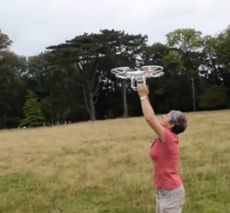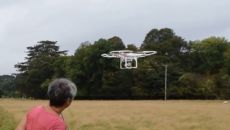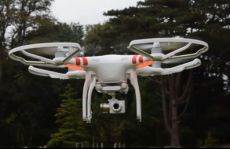
Susan Blackmore meets a drone
This week Stephen Hawking, the famous British scientist who is almost completely paralysed and speaks through a machine, said that AI could end all human life. "It would take off on its own, and re-design itself at an ever increasing rate," he said.
I think he may be right but for a completely different reason. Hawking, like many other thinkers, seems to imagine AI as being confined to a single robot or a large machine of some kind. My fear is that a distributed kind of intelligence is already emerging in the great cloud we are so enthusiastically building and feeding with information.
My thinking comes straight from evolutionary theory. On this planet life emerged nearly 4 billion years ago based first on RNA and then on DNA. So genes are often considered to be the first replicator; the first kind of information that was copied, varied and then subject to natural selection. This is what led to the evolution of all of life’s diversity.
Then it took until about a million years ago for the second replicator to emerge – we call them memes . Our ancestors began to imitate each other, copying sounds and actions that varied and then were selectively copied by others. From these early memes, culture spread at first very slowly and then faster and faster until the surface of the planet was dramatically changed by agriculture, herding and building. The planet’s whole atmosphere was changed and its climate threatened.
Could there now be a third replicator emerging? This is a question I have been exploring for the past few years, starting with my TED lecture in 2008. I now think the answer is Yes.
Memes emerged when just one of the billions of gene products began copying, varying and selecting a new sort of information – words, stories, actions and technologies. Now the silicon based machinery that we have built is capable of copying, varying and selecting digital information. This information, I suggest, could be a third replicator. I first called these replicators the ‘temes’ – for ‘technological memes’ – but people were so confused by the spelling that I have changed the name to ‘tremes’. I am very sorry if this causes any more confusion!
So what do replicators do? They get copied whenever and wherever they can – whenever the necessary machinery and raw materials are available. This is why they are called ‘selfish replicators’. They just get copied, or not, without regard for the consequences for us, for other life, or for our planet.
We humans are now busy linking up all the many machines we have created – computers, tablets, phones and little chips inside all sorts of ordinary, everyday objects. We enthusiastically upload our words, stories, images and videos, more and more every day. It was recently estimated that 100 hours of video are uploaded to YouTube every minute. All this data might be harmless without software but we are also uploading plenty of that. There are search engines that select data, programs that write articles as though they were journalists, ones that record what you buy and suggest what you’d like next, and others that track the positions of phones and cars wherever they go. There is software that writes other software, and software that is capable, like some computer viruses, of escaping and copying itself in unpredicted ways. My guess is that all this constitutes a new evolutionary system that is rapidly expanding far beyond our control.
Isn’t this dangerous? Yes, because we can neither fully understand nor control what is going on. We might have control if we didn’t want the new technology. We might if we were willing to do without GPS, without clever phones, and without the promise of an Internet of things to make our lives easier. But we are not. We want all these things and many of the cleverest people on earth are busy creating them for us.
So we have genes, memes and now tremes – the digital third replicator. We have a new digital system that is fast being connected up in ways reminiscent of a living brain. Will intelligence emerge in this new system? If so what kind of intelligence? Will it have emotions, be conscious or capable of suffering? Will it care at all about us?
One thing it currently lacks is any real-time senses that it can control. We humans have eyes, ears, noses and skin to detect the world around us as we move through it. You might say that our new cloud of computing power has nothing like this. It has access to Google Earth, to trillions of photos, to phone calls and emails, but it can’t actually look around the world for itself.

This is why I was so gripped when a friend of mine turned up at my house with his new toy – an ‘unmanned aerial vehicle’ or drone. This red and white quadcopter, with a big lens underneath for an eye, fascinated and entranced me as my friend fixed a phone on to record its adventures and sent it flying. The drone came and looked me up and down, approached and circled me. I looked back and wondered what it was thinking. I wanted to communicate with it – make friends with it even. Of course I knew it wasn’t thinking anything. But could it be part of something that thinks? If the video it took were uploaded and found its way to software connecting millions of such drones would this be the eye of the tremes?

Watching you
Watch our 2 minutes video. Imagine drones like this filling the sky, equipped with chemical sensors, infra-red cameras or any other kind of sensors and all connected to the web and to rapidly evolving software. Imagine how many people will want these toys when the price comes down, as it certainly will. Even now they are expected to be a must-have Christmas present.
If I’m right (and I have to say, most people I know of think I’m wrong) then we need to get our heads around what is happening very fast, because this new world won’t wait for us to catch up.




